
Chytolita is a monotypic litter moth genus of the family Erebidae erected by Augustus Radcliffe Grote in 1873. Its only species, Chytolita morbidalis, the morbid owlet moth or morbid owlet, was first described by Achille Guenée in 1854. It is found in large parts of North America, from coast to coast in the north and south to North Carolina, Texas and Florida in the west. The habitat consists of deciduous woods and edges.
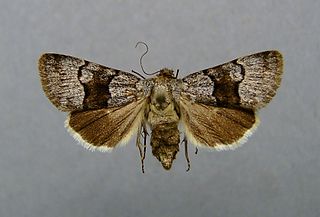
Sympistis is a genus of moths of the family Noctuidae. The genus was erected by Jacob Hübner in 1823.

Sympistis sandaraca is a moth of the family Noctuidae first described by John S. Buckett and William R. Bauer in 1967. It is found in North America from the mountains of south-western Alberta south to at least Colorado and California.

Acronicta sperata, the hopeful dagger moth, is a moth of the family Noctuidae. The species was first described by Augustus Radcliffe Grote in 1873. It is found in North America from New Brunswick west to the Alberta foothills, south to the District of Columbia, Missouri and in the mountains to Colorado.

Catocala meskei, or Meske's underwing, is a moth of the family Erebidae. The species was first described by Augustus Radcliffe Grote in 1873. It is found in North America from Maine and Quebec west to southern Alberta and Montana, south to South Carolina in the east and at least Montana in the west.

Agrotis vancouverensis, the Vancouver dart, is a moth of the family Noctuidae. The species was first described by Augustus Radcliffe Grote in 1873. It is found in the Pacific Northwest of North America and is common west of the Cascade Mountains.
Sympistis hayesi is a moth of the family Noctuidae first described by Augustus Radcliffe Grote in 1873. It is found in the Rocky Mountain region of North America.

Globia subflava, the subflava sedge borer or yellow sedge borer, is a moth of the family Noctuidae. The species was first described by Augustus Radcliffe Grote in 1882. It is found in North America from Nova Scotia west to British Columbia, south to New Jersey in the east and Utah and California in the west.

Schinia meadi, or Mead's flower moth, is a moth of the family Noctuidae. The species was first described by Augustus Radcliffe Grote in 1873. It is found in western North America from south central Saskatchewan and central Alberta west to south central Washington, south to Arizona and New Mexico.

Schinia nuchalis, the spotted sage moth, is a moth of the family Noctuidae. The species was first described by Augustus Radcliffe Grote in 1878. It is found from the Great Plains and Great Basin, from southern Saskatchewan, Alberta and British Columbia south to northern Arizona. The Eurasian Schinia scutosa is no longer considered a synonym of Schinia nuchalis.
Schinia persimilis, the persimilis flower moth, is a moth of the family Noctuidae. The species was first described by Augustus Radcliffe Grote in 1873. It is found from in western North America from east central Alberta and the Cypress Hills in Saskatchewan north to the southern Yukon, west and south to Colorado, Utah, California and Oregon.
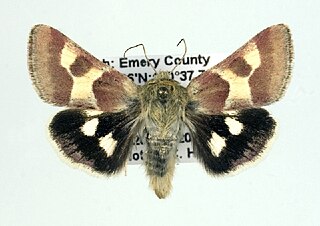
Schinia suetus is a moth of the family Noctuidae first described by Augustus Radcliffe Grote in 1873. It is widespread in the mountains of western North America, from southern Alberta west to British Columbia, south at least to Colorado and California, east to Idaho and New Mexico.

Acronicta lupini, the lupine dagger or little bear, is a moth of the family Noctuidae. The species was first described by Augustus Radcliffe Grote in 1873. It is found from Quebec, Newfoundland and Labrador, British Columbia, Alberta and Yukon in Canada, south to California.

Colocasia propinquilinea, the closebanded yellowhorn, is a moth of the family Noctuidae. The species was first described by Augustus Radcliffe Grote in 1873. It is found in North America from Newfoundland and Labrador, west across the southern edge of the boreal forest to central Alberta, south to North Carolina, Missouri and Arkansas.
Copablepharon longipenne, the dusky dune moth, is a moth of the family Noctuidae. The species was first described by Augustus Radcliffe Grote in 1882. It is found in North America from south-western Manitoba to southern Alberta, south to western Texas.
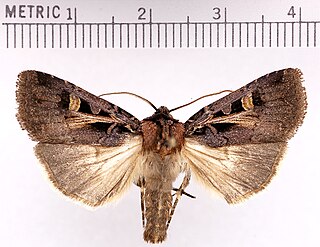
Feltia herilis, the herald dart or Master's dart, is a moth of the family Noctuidae. The species was first described by Augustus Radcliffe Grote in 1873. It is found in North America from Vancouver Island to Newfoundland, north to the Northwest Territories border and south to the Gulf Coast.
Chrysanympha formosa, the Formosa looper, is a moth of the family Noctuidae. The species was first described by Augustus Radcliffe Grote in 1865. It is found in North America from Newfoundland west to Manitoba and south to the mountains of North Carolina and Tennessee.

Trichordestra legitima, the striped garden caterpillar, is a moth of the family Noctuidae. The species was first described by Augustus Radcliffe Grote in 1864. It is found in eastern North America, from Newfoundland to Florida, west to Texas, north to Saskatchewan.
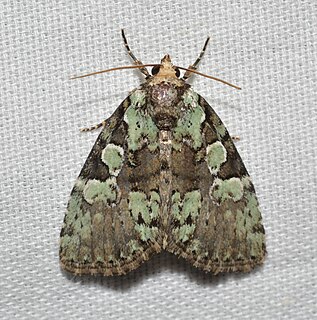
Leuconycta lepidula, the marbled-green leuconycta moth, marbled-green jaspidia or dark leuconycta, is a moth of the family Noctuidae. The species was first described by Augustus Radcliffe Grote in 1874. It is found in North America from Nova Scotia to North Carolina, west to Texas and north to Alberta.
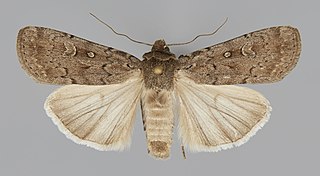
Actebia balanitis is a moth of the family Noctuidae first described by Augustus Radcliffe Grote in 1873. It is found from north-east Alaska and western Yukon east to east central Saskatchewan and north central South Dakota, south to northern Colorado and west to central Washington and the dry interior of British Columbia. The wingspan is 36–40 mm. Adults are on wing from June to August depending on the location. There is one generation per year.













